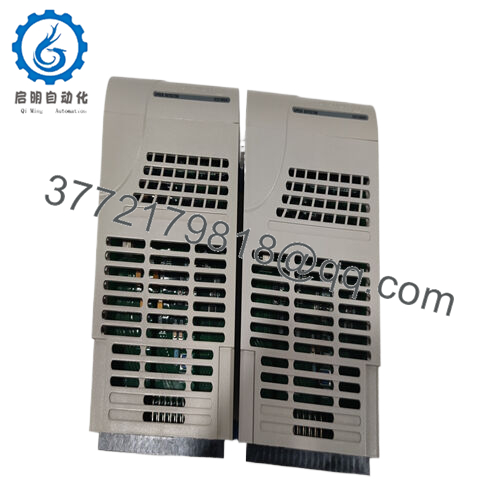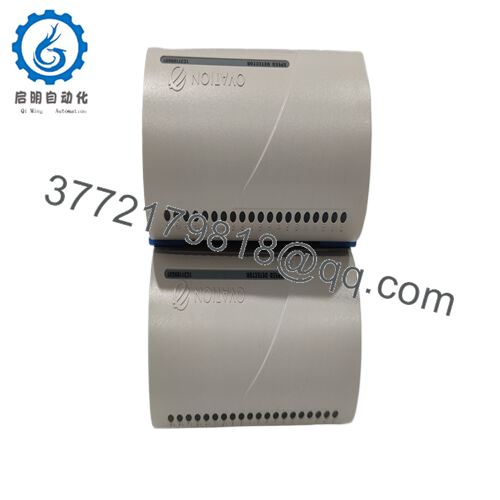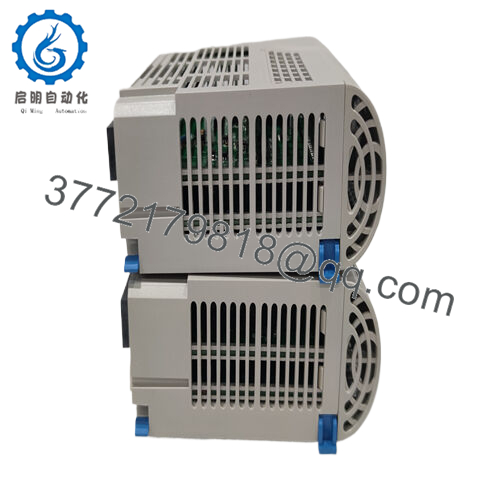Description
Product Model: 1C31189G01
Product Brand: Emerson (Ovation)
Product Series: Speed Detector / Input Interface
Product Features:
- 8 channels of speed detection support (pulse, sine, encoder)
- Dual-mode resolution: 16-bit (200 Hz to 51,200 Hz) and 32-bit (0.72 Hz to 65,535 Hz) operation
- Measurement accuracy up to ±0.1% and wide measurement range (0 to 100,000 RPM)
- Rugged industrial design: input voltage support 12–24 VDC, IP20 enclosure, built for harsh environments
Product Role & System Fit
In the Emerson Ovation ecosystem, EMERSON 1C31189G01 plays the critical role of a Speed Detector Input Module. It sits inside the I/O shelf of a DCS rack and handles the interface to rotating sensors—such as tachometers, pulse sensors, encoders, or sine wave pickups. The controller logic then consumes its digitized speed outputs for steam turbines, pumps, compressors, or other rotating equipment.
Because speed sensing must be precise and fast, 1C31189G01 is optimized for low-latency, clean signal capture. It offers both “low-res” 16-bit and “high-res” 32-bit modes, allowing systems to choose between throughput and fine resolution depending on the loop requirements.
In many control systems, the 1C31189G01 is deployed in parallel with other modules (e.g. analog inputs, discrete I/O, valve positioners). It shares the backplane power and communicates with the main controller through the typical Ovation bus. As a modular card, it can be hot-swapped in redundant configurations, provided wiring and system logic support such architectures.
Because it supports multiple sensor types—pulse, sine, and encoder—the 1C31189G01 is versatile in retrofit projects. In plants where legacy sensors feed into modern systems, this module often bridges compatibility gaps, making it a common upgrade in power plants, petrochemical sites, and critical process industries.
- 1C31189G01
Applications & Industry Context
Rotational speed is a foundational parameter across multiple industries. EMERSON 1C31189G01 finds use wherever RPM (or frequency of revolution) is essential to control, protection, or monitoring:
- Power Generation: Turbine shaft speed, generator RPM, boiler feed pump speed, bypass valves requiring rotational feedback
- Oil & Gas / Petrochemicals: Compressors, turboexpanders, gas turbines, and auxiliary rotating machinery
- Pulp & Paper / Paper Mills: Drive rolls, refiner shafts, dryer cylinders
- Water & Wastewater / Pump Stations: Large centrifugal pumps, booster systems
- Process Plants / Chemical Industry: Agitator drives, stirrers, mixers, and auxiliary fans
In many cases, speed data is used not just for feedback control but for protection (e.g. overspeed trips). The 1C31189G01’s capacity to detect high-resolution frequencies with fast updates makes it suitable even for safety-critical loops.
In plants I’ve visited, replacing aging analog tachometer cards with a module like 1C31189G01 immediately improved diagnostics. The newer module would flag sensor drift or intermittent signals—something the legacy card couldn’t. This early-warning capability prevented unplanned outages.
Given its industrial toughness, the 1C31189G01 handles environments with vibration, EMI, and thermal stress. Its enclosure is rated at IP20, and its components are chosen to retain calibration through startup/shutdown cycles.
Technical Features & Benefits
Let’s dig into the functionality and advantages that EMERSON 1C31189G01 brings to your control architecture:
1. Multi-Channel Speed Detection
With 8 independent channels, 1C31189G01 lets you monitor multiple sensors concurrently. This is important in systems with multiple shafts or redundant sensors.
2. Dual Resolution Modes
- 16-bit (Low Resolution) mode covers 200 Hz to 51,200 Hz — suitable for fast-turning machinery where you need high throughput. 32-bit (High Resolution) mode expands the range: 0.72 Hz to 65,535 Hz, enabling measurement of slow rotations or fine speed control loops.
This dual-mode flexibility means a single module handles both high-speed and low-speed loops, which reduces inventory variety.
3. Wide Measurement Range and Accuracy
The module supports frequency inputs from very low up to about 65 kHz (for high-res mode) and handles rotational speeds up to 100,000 RPM in many use cases. Accuracy is specified up to ±0.1%, giving confidence in closed-loop control or protective logic.
4. Flexible Sensor Interface
It supports multiple sensor types: pulse (digital), sine wave pickups, and encoder signals. This makes it applicable across different sensor technologies without needing external converters.
5. Signal Conditioning, Filtering & Averaging
The module can apply configurable filtering or averaging to smooth out noise or transient disturbances. This is especially useful in real industrial settings where electromagnetic interference or mechanical jitter can perturb readings.
6. LED Status Indication & Diagnostics
Visual LEDs on the module allow quick identification of input signals or fault states. A healthy, properly connected module provides intuitive feedback during commissioning and troubleshooting.
7. Robust Design for Industrial Environments
The module handles input voltages from 12 to 24 VDC and operates over wide temperature ranges (typically –40 °C to +70 °C). Its IP20 housing and solid internal design resist vibration, electrical noise, and temperature cycling.
8. Compact Form Factor
The 1C31189G01 is compact: about 130 mm × 100 mm × 70 mm according to some sources, and weighs roughly 0.5 kg. Another reference gives 4.8 oz (≈ 0.10 kg) for a smaller listing, but packaging differences may apply.
From field experience: when migrating old turbine plants, we swapped analog tach generator cards for a module like 1C31189G01. Immediately we saw fewer false speed alarms during startup transients, and increased resolution near standby speeds—allowing smoother ramp control.
Technical Specifications Table
Here is a consolidated spec table for EMERSON 1C31189G01 (based on multiple sources):
| Parameter | Value / Range | Notes / Conditions |
|---|---|---|
| Input Channels | 8 speed input channels | Supports multiple sensors simultaneously |
| Resolution / Mode | 16-bit: 200 Hz to 51,200 Hz 32-bit: 0.72 Hz to 65,535 Hz | Enables both high-speed and low-speed loops |
| Measurement Range | Up to ~100,000 RPM | Typical maximum application range |
| Accuracy | ±0.1% | Under ideal conditions |
| Input Voltage | 12–24 VDC | Module supply for sensors |
| Operating Temperature | –40 °C to +70 °C | Industrial temperature range |
| Storage Temperature | –55 °C to +85 °C (typical) | For transportation or cold storage (some spec references) |
| Dimensions | 130 × 100 × 70 mm | One cited form factor |
| Weight | ~0.5 kg | Typical quoted weight |
| Enclosure / Protection | IP20 | Protection rating under normal use |
| Sensor Support | Pulse, sine wave, encoder | Versatile interface support |
| LED Indicators | Input signal, module status | For visual supervision |
Note: Some smaller spec listings list the module weight as low as 0.1 kg and dimensions of 1.0 in × 4.8 in × 3.8 in (≈ 25 × 122 × 97 mm) —these could reflect packaging, partial modules, or variant subassemblies. Always validate against original Emerson data.
Installation & Maintenance Insights
To get reliable performance out of EMERSON 1C31189G01, follow these field best practices:
- Mounting & Ventilation: Install in a rack with free clearance on top and bottom to allow airflow. Avoid placing hot modules directly above or adjacent to it.
- Wiring Practices: Use shielded twisted-pair cables for analog or encoder signals. Ground sensor shield at one point only (single-point ground) to prevent noise loops.
- Power Sequencing: Always de-energize the backplane before inserting or removing a module. Although hot-swap might be supported in some redundant systems, the preferred practice is to follow cold insertion where possible.
- Commissioning Checks: After installation, run each channel through its frequency range. Check for linearity, stability, and noise susceptibility. Enable filtering carefully—too much filtering may delay response for fast loops.
- Diagnostics & Monitoring: Leverage LED indicators during startup to see which channels see valid input. Monitor signal health over time—look for channels that show intermittent readings or jump in noise.
- Periodic Inspections: At maintenance intervals (e.g. every 6–12 months), inspect connector integrity, reseal cable clamping, clean dust and debris, re-torque terminal screws.
- Spare Card Strategy: Keep a preconfigured 1C31189G01 card (same calibration, firmware) in stock, so you can swap quickly if one fails. Make sure the spare is stored in a controlled environment.
- Burn-In Testing: Before deploying in critical loops, operate the card in lab conditions under load (with input signals) for 24–48 hours. That can weed out latent defects before field deployment.
Because speed detection is often essential to safety or control loops, downtime due to module failure can be costly. The above maintenance regimen ensures high uptime.




 WhatsApp: +86 16626708626
WhatsApp: +86 16626708626 Email:
Email:  Phone: +86 16626708626
Phone: +86 16626708626


